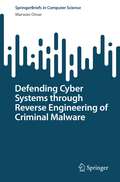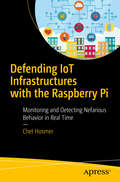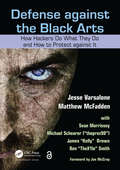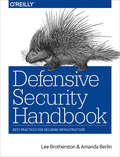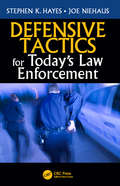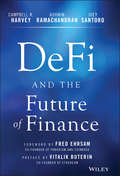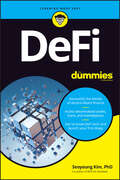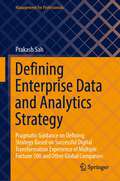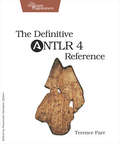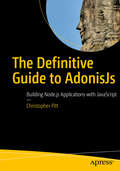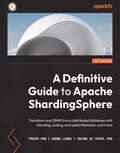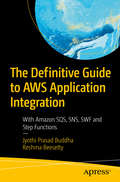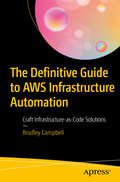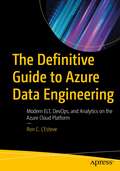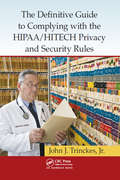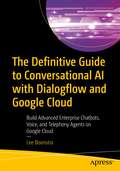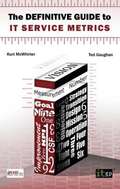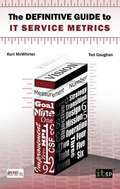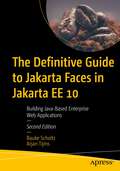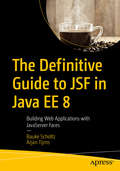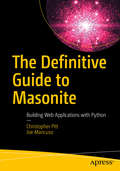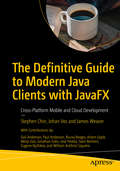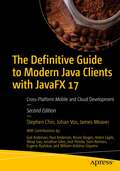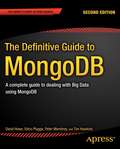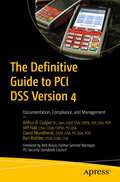- Table View
- List View
Defending Cyber Systems through Reverse Engineering of Criminal Malware (SpringerBriefs in Computer Science)
by Marwan OmarThis SpringerBrief discusses underlying principles of malware reverse engineering and introduces the major techniques and tools needed to effectively analyze malware that targets business organizations. It also covers the examination of real-world malware samples, which illustrates the knowledge and skills necessary to take control of cyberattacks.This SpringerBrief explores key tools and techniques to learn the main elements of malware analysis from the inside out. It also presents malware reverse engineering using several methodical phases, in order to gain a window into the mind set of hackers. Furthermore, this brief examines malicious program’s behavior and views its code-level patterns. Real world malware specimens are used to demonstrate the emerging behavioral patterns of battlefield malware as well.This SpringerBrief is unique, because it demonstrates the capabilities of emerging malware by conducting reverse-code engineering on real malware samples and conducting behavioral analysis in isolated lab system. Specifically, the author focuses on analyzing malicious Windows executables. This type of malware poses a large threat to modern enterprises. Attackers often deploy malicious documents and browser-based exploits to attack Windows enterprise environment. Readers learn how to take malware inside-out using static properties analysis, behavioral analysis and code-level analysis techniques.The primary audience for this SpringerBrief is undergraduate students studying cybersecurity and researchers working in this field. Cyber security professionals that desire to learn more about malware analysis tools and techniques will also want to purchase this SpringerBrief.
Defending IoT Infrastructures with the Raspberry Pi: Monitoring And Detecting Nefarious Behavior In Real Time
by Chet HosmerApply a methodology and practical solutions for monitoring the behavior of the Internet of Things (IoT), industrial control systems (ICS), and other critical network devices with the inexpensive Raspberry Pi. With this book, you will master passive monitoring and detection of aberrant behavior, and learn how to generate early indications and warning of attacks targeting IoT, ICS, and other critical network resources. Defending IoT Infrastructures with the Raspberry Pi provides techniques and scripts for the discovery of dangerous data leakage events emanating from IoT devices. Using Raspbian Linux and specialized Python scripts, the book walks through the steps necessary to monitor, detect, and respond to attacks targeting IoT devices. There are several books that cover IoT, IoT security, Raspberry Pi, and Python separately, but this book is the first of its kind to put them all together. It takes a practical approach, providing an entry point and level playing field for a wide range of individuals, small companies, researchers, academics, students, and hobbyists to participate. What You’ll Learn Create a secure, operational Raspberry Pi IoT sensorConfigure and train the sensor using “normal” IoT behaviorEstablish analytics for detecting aberrant activitiesGenerate real-time alerts to preempt attacksIdentify and report data-leakage events originating from IoT devicesDevelop custom Python applications for cybersecurity Who This Book Is For Cybersecurity specialists, professors teaching in undergraduate and graduate programs in cybersecurity, students in cybersecurity and computer science programs, software developers and engineers developing new cybersecurity defenses, incident response teams, software developers and engineers in general, and hobbyists wanting to expand the application of Raspberry Pi into both IoT and cybersecurity
Defense against the Black Arts: How Hackers Do What They Do and How to Protect against It
by Jesse Varsalone Matthew McFaddenExposing hacker methodology with concrete examples, this volume shows readers how to outwit computer predators. With screenshots and step by step instructions, the book discusses how to get into a Windows operating system without a username or password and how to hide an IP address to avoid detection. It explains how to find virtually anything on the Internet and explores techniques that hackers can use to exploit physical access, network access, and wireless vectors. The book profiles a variety of attack tools and examines how Facebook and other sites can be used to conduct social networking attacks.
Defensive Security Handbook: Best Practices for Securing Infrastructure
by Lee Brotherston Amanda BerlinDespite the increase of high-profile hacks, record-breaking data leaks, and ransomware attacks, many organizations don’t have the budget to establish or outsource an information security (InfoSec) program, forcing them to learn on the job. For companies obliged to improvise, this pragmatic guide provides a security-101 handbook with steps, tools, processes, and ideas to help you drive maximum-security improvement at little or no cost.Each chapter in this book provides step-by-step instructions for dealing with a specific issue, including breaches and disasters, compliance, network infrastructure and password management, vulnerability scanning, and penetration testing, among others. Network engineers, system administrators, and security professionals will learn tools and techniques to help improve security in sensible, manageable chunks.Learn fundamentals of starting or redesigning an InfoSec programCreate a base set of policies, standards, and proceduresPlan and design incident response, disaster recovery, compliance, and physical securityBolster Microsoft and Unix systems, network infrastructure, and password managementUse segmentation practices and designs to compartmentalize your networkExplore automated process and tools for vulnerability managementSecurely develop code to reduce exploitable errorsUnderstand basic penetration testing concepts through purple teamingDelve into IDS, IPS, SOC, logging, and monitoring
Defensive Tactics for Today’s Law Enforcement
by Stephen K. Hayes Joe NiehausFew of the many defensive tactics books on the market include the training and methods of martial arts. Drawing on the centuries-old techniques of Ninjutsu, Defensive Tactics for Today’s Law Enforcement offers alternatives to the traditional police defensive tactics taught to most officers. This text stresses relying on natural tendencies in a violent encounter to ensure officer safety and to better utilize the techniques and training officers do receive. By integrating existing training with martial arts expertise, Defensive Tactics provides officers access a full complement of techniques to better navigate physical conflict safely and effectively. Intended for law enforcement practitioners, as well as practitioners of any other professions that present a personal security risk, Defensive Tactics for Today’s Law Enforcement will better equip readers with a diverse range of defensive tactics.
DeFi and the Future of Finance
by Campbell R. Harvey Ashwin Ramachandran Joey SantoroDuring the Global Financial Crisis in 2008, our financial infrastructure failed. Governments bailed out the very institutions that let the economy down. This episode spurred a serious rethink of our financial system. Does it make any sense that it takes two days to settle a stock transaction? Why do retailers, operating on razor thin margins, have to pay 3% for every customer credit card swipe? Why does it take two days to transfer money from a bank account to a brokerage—or any other company? Why are savings rates miniscule or negative? Why is it so difficult for entrepreneurs to get financing at traditional banks? In DeFi and the Future of Finance, Campbell R. Harvey, Ashwin Ramachandran and Joey Santoro, introduce the new world of Decentralized Finance. The book argues that the current financial landscape is ripe for disruption and we are seeing, in real time, the reinvention of finance. The authors provide the reader with a clear assessment of the problems with the current financial system and how DeFi solves many of these problems. The essence of DeFi is that we interact with peers—there is no brick and mortar and all of the associated costs. Savings and lending are reinvented. Trading takes place with algorithms far removed from traditional brokerages. The book conducts a deep dive on some of the most innovative protocols such as Uniswap and Compound. Many of the companies featured in the book you might not have heard of—however, you will in the future. As with any new technology, there are a myriad of risks and the authors carefully catalogue these risks and assess which ones can be successfully mitigated. Ideally suited for people working in any part of the finance industry as well as financial policy makers, DeFi and the Future of Finance gives readers a vision of the future. The world of finance will fundamentally be changed over the coming decade. The book enables you to become part of the disruption – not the target of the disruption.
DeFi For Dummies
by Seoyoung KimGet to know the building blocks of a new economy The promise of decentralized finance (DeFi for those up on their financial lingo) as a disruptor to financial institutions makes it must-know for anyone involved in finance. DeFi For Dummies provides an easy-to-understand option for unraveling the past, present, and future of DeFi. Understand current DeFi applications, including how to build basic applications on the leading platforms, and get a look into the future&’s most promising new DeFi solutions. Staying ahead of the game is critical for finance professionals these days, and this Dummies guide makes it possible, with full coverage of how DeFi affects asset management, lending and borrowing, and investment markets. Wrap your mind around DeFi and start getting hands on, the Dummies way. Learn how the DeFi revolution started and where it&’s going Get insight into opportunities for getting started and building value with DeFi Discover the leading assets, exchanges, and marketplaces built on DeFi principles Create secure DeFi applications on established platformsThis book is great for current pros or active investors in the world of finance who need to get up to speed on the world of DeFi as quickly and clearly as possible.
Defining Enterprise Data and Analytics Strategy: Pragmatic Guidance on Defining Strategy Based on Successful Digital Transformation Experience of Multiple Fortune 500 and Other Global Companies (Management for Professionals)
by Prakash SahThis is the first of its kind book that describes key elements of enterprise data and analytics strategy, and prescribes a pragmatic approach to define the strategy for large enterprises. The book is based on successful digital transformation experience of multiple Fortune 500 and other large enterprises. It is estimated that more than 50% of data and analytics initiatives fail globally because of the inherent complexity of such initiatives. Some of the questions that enterprises struggle with are: How to define enterprise data and analytics strategy? What are the key elements that should be considered while doing so? Why one-size-fits-all approach does not work for all enterprises? How to align data and analytics initiative with the business strategy of the CEO? How to establish a futuristic technology and architecture foundation, given the exponential rate of innovation in data and analytics technologies? How to define the right data and analytics organization model? Why data and analytics organization and processes need to be different from other functions? How to manage organizational change to ensure success of data and analytics initiative? How to define a business value measurement framework and calculate ROI from data and analytics initiative? What are the key skills required in a data and analytics leader to wade through political and other challenges of a large enterprise? This book will help executives, chief digital/analytics officers, data and analytics professionals, and consultants, in answering the above questions. It will help them in addressing various dilemmas that they face every day and making their enterprises data-driven.
The Definitive ANTLR 4 Reference (Oreilly And Associate Ser.)
by Terence ParrProgrammers run into parsing problems all the time. Whether it's a data format like JSON, a network protocol like SMTP, a server configuration file for Apache, a PostScript/PDF file, or a simple spreadsheet macro language--ANTLR v4 and this book will demystify the process. ANTLR v4 has been rewritten from scratch to make it easier than ever to build parsers and the language applications built on top. This completely rewritten new edition of the bestselling Definitive ANTLR Reference shows you how to take advantage of these new features.Build your own languages with ANTLR v4, using ANTLR's new advanced parsing technology. In this book, you'll learn how ANTLR automatically builds a data structure representing the input (parse tree) and generates code that can walk the tree (visitor). You can use that combination to implement data readers, language interpreters, and translators. You'll start by learning how to identify grammar patterns in language reference manuals and then slowly start building increasingly complex grammars. Next, you'll build applications based upon those grammars by walking the automatically generated parse trees. Then you'll tackle some nasty language problems by parsing files containing more than one language (such as XML, Java, and Javadoc). You'll also see how to take absolute control over parsing by embedding Java actions into the grammar. You'll learn directly from well-known parsing expert Terence Parr, the ANTLR creator and project lead. You'll master ANTLR grammar construction and learn how to build language tools using the built-in parse tree visitor mechanism. The book teaches using real-world examples and shows you how to use ANTLR to build such things as a data file reader, a JSON to XML translator, an R parser, and a Java class->interface extractor. This book is your ticket to becoming a parsing guru!What You Need:ANTLR 4.0 and above. Java development tools. Ant build system optional(needed for building ANTLR from source)
The Definitive Guide to AdonisJs: Building Node. Js Applications With Javascript
by Christopher PittLearn everything you need to master the AdonisJs framework, including topics such as interacting with a database, rendering templates, writing asynchronous code, and hosting sites with SSL. Along the way, you’ll see how to build a commerce application, which lists products and allows shoppers to register and purchase those products. The site will feature a product catalog, a shopping cart, user registration and login, and profile management.The Definitive Guide to AdonisJs also covers how to create a front-end build chain, so that you can use a modern front-end framework, such as React. You’ll discover how to connect your front end to the server, so that data and transactions can be shared between the two. Finally, you’ll see how to secure and deploy the application to a virtual private server, including how to apply for and install an SSL certificate and start accepting payments.After reading and using this book, you’ll know all you need about AdonisJs. You’ll have the tools to turn that side-project you’ve been thinking about into a real money-making product. It is written by a web expert and reviewed by the AdonisJs project lead. This is the complete start-to-finish guide you’ve been waiting for. What You'll LearnSet up Node.js and AdonisJs, so that you can start building your application Create and use views and template codeImplement cooperative multitasking, in JavaScriptRepresent eventual values with AdonisJs promisesOrganize and isolate your code in controllers and decorate them with middleware, to do things like authenticationBuild queries, using the Lucid DSL, and package these database entities up into model classesValidate form data and respond with the appropriate error messagesRespond to general framework errors with custom error pagesLearn the deeper parts of sessions and cookiesUpdate the state of the user interface with WebSocketsHost AdonisJs applications in a modern hosting environmentWho This Book Is ForReaders should have a functional understanding of JavaScript.
A Definitive Guide to Apache ShardingSphere: Transform any DBMS into a distributed database with sharding, scaling, encryption features, and more
by Trista Pan Zhang Liang Yacine Si TayebBecome well versed with all of ShardingSphere's features for every data management need with this comprehensive guide put together by ShardingSphere's founder and core contributorsKey FeaturesUnderstand the core concepts and efficiently set up Apache ShardingSphereEnhance existing databases with sharding, elastic scaling, encryption, governance features, and moreImport and customize the ecosystem's core features for various application scenariosBook DescriptionApache ShardingSphere is a new open source ecosystem for distributed data infrastructures based on pluggability and cloud-native principles that helps enhance your database.This book begins with a quick overview of the main challenges faced by database management systems (DBMSs) in production environments, followed by a brief introduction to the software's kernel concept. After that, using real-world examples of distributed database solutions, elastic scaling, DistSQL, synthetic monitoring, database gateways, and SQL authority and user authentication, you'll fully understand ShardingSphere's architectural components, how they're configured and can be plugged into your existing infrastructure, and how to manage your data and applications. You'll also explore ShardingSphere-JDBC and ShardingSphere-Proxy, the ecosystem's clients, and how they can work either concurrently or independently to address your needs. You'll then learn how to customize the plugin platform to define personalized user strategies and manage multiple configurations seamlessly. Finally, the book enables you to get up and running with functional and performance tests for all scenarios.By the end of this book, you'll be able to build and deploy a customized version of ShardingSphere, addressing the key pain points encountered in your data management infrastructure.What you will learnAssemble a custom solution using the software's pluggable architectureDiscover how to use Database Plus features effectivelyUnderstand the difference between ShardingSphere-JDBC and ShardingSphere-ProxyGet to grips with ShardingSphere's pluggability mechanismExplore mainstream test models for databases and distributed databasesPerform migrations from an on-premise database to a cloud-based databaseReconfigure your data infrastructure and eliminate switching costsWho this book is forThis book is for database administrators working with distributed database solutions who are looking to explore the capabilities of Apache ShardingSphere. DBAs looking for more capable, flexible, and cost-effective alternatives to the solutions they're currently utilizing will also find this book helpful. To get started with this book, a basic understanding of, or even an interest in, databases, relational databases, SQL languages, cloud computing, and data management in general is needed.
The Definitive Guide to AWS Application Integration: With Amazon SQS, SNS, SWF and Step Functions
by Jyothi Prasad Buddha Reshma BeesettyBuild reliable, asynchronous, and distributed applications using message queuing and task orchestration capabilities of Amazon Web Services (AWS) Application Integration. This book prepares you to build distributed applications and administrators, and manage queues, workflows, and state machines.You'll start by reviewing key AWS prerequisite services such as EC2, Lambda, S3, DynamoDB, CloudWatch, and IAM. Simple Queue Service (SQS) and SNS Simple Notification Service (SNS) are then covered to show how applications interact with each other in a reliable and resilient fashion. Next, workflow building with (Simple Workflow Service (SWF) for orchestration of tasks is explained and in the final chapter learn the techniques for building a state using Step Functions, Simple Workflow Service along with Flow Framework. The book illustrates all the concepts using numerous examples that work with SDK, CLI, and Console. Most of the code examples are in Java, followed by Python and JavaScript. What You Will LearnUnderstand the important prerequisites of AWS, such as EC2, Lambda, S3, and DynamoDBWork with SQS, SNS, and SWS functionsReview Step functionsWho This Book Is ForAWS developers and software developers proficient in Java, Python and JavaScript.
The Definitive Guide to AWS Infrastructure Automation: Craft Infrastructure-as-Code Solutions
by Bradley CampbellDiscover the pillars of AWS infrastructure automation, starting with API-driven infrastructure concepts and its immediate benefits such as increased agility, automation of the infrastructure life cycle, and flexibility in experimenting with new architectures. With this base established, the book discusses infrastructure-as-code concepts in a general form, establishing principled outcomes such as security and reproducibility. Inescapably, we delve into how these concepts enable and underpin the DevOps movement. The Definitive Guide to AWS Infrastructure Automation begins by discussing services and tools that enable infrastructure-as-code solutions; first stop: AWS's CloudFormation service. You’ll then cover the ever-expanding ecosystem of tooling emerging in this space, including CloudFormation wrappers such as Troposphere and orchestrators such as Sceptre, to completely independent third-party tools such as Terraform and Pulumi. As a bonus, you’ll also work with AWS' newly-released CDK (Cloud Development Kit). You’ll then look at how to implement modular, robust, and extensible solutions across a few examples -- in the process building out each solution with several different tools to compare and contrast the strengths and weaknesses of each. By the end of the journey, you will have gained a wide knowledge of both the AWS-provided and third-party ecosystem of infrastructure-as-code/provisioning tools, and the strengths and weaknesses of each. You’ll possess a mental framework for how to craft an infrastructure-as-code solution to solve future problems based on examples discussed throughout the book. You’ll also have a demonstrable understanding of the hands-on operation of each tool, situational appropriateness of each tool, and how to leverage the tool day to day. What You Will Learn Discover the technological and organizational benefits to infrastructure-as-code solutions Examine the overall landscape of infrastructure-as-code tooling and solutions available to consumers of AWS services See the strengths and weaknesses of these tools relative to one another as examined through hands-on implementation of several solutions Gain hands-on experience, best practices, and tips and tricks learned through several years’ real-world experience delivering solutions using these very tools in a wide variety of scenarios Engineer solid solutions that leave room for new requirements and changes without requiring needless refactoring Who This Book Is For DevOps engineers, cloud engineers and architects focused on the AWS ecosystem, software engineers/developers working within the AWS ecosystem, and engineering leaders looking for best practices.
The Definitive Guide to Azure Data Engineering: Modern ELT, DevOps, and Analytics on the Azure Cloud Platform
by Ron C. L'EsteveBuild efficient and scalable batch and real-time data ingestion pipelines, DevOps continuous integration and deployment pipelines, and advanced analytics solutions on the Azure Data Platform. This book teaches you to design and implement robust data engineering solutions using Data Factory, Databricks, Synapse Analytics, Snowflake, Azure SQL database, Stream Analytics, Cosmos database, and Data Lake Storage Gen2. You will learn how to engineer your use of these Azure Data Platform components for optimal performance and scalability. You will also learn to design self-service capabilities to maintain and drive the pipelines and your workloads. The approach in this book is to guide you through a hands-on, scenario-based learning process that will empower you to promote digital innovation best practices while you work through your organization’s projects, challenges, and needs. The clear examples enable you to use this book as a reference and guide for building data engineering solutions in Azure. After reading this book, you will have a far stronger skill set and confidence level in getting hands on with the Azure Data Platform.What You Will LearnBuild dynamic, parameterized ELT data ingestion orchestration pipelines in Azure Data FactoryCreate data ingestion pipelines that integrate control tables for self-service ELTImplement a reusable logging framework that can be applied to multiple pipelinesIntegrate Azure Data Factory pipelines with a variety of Azure data sources and toolsTransform data with Mapping Data Flows in Azure Data FactoryApply Azure DevOps continuous integration and deployment practices to your Azure Data Factory pipelines and development SQL databasesDesign and implement real-time streaming and advanced analytics solutions using Databricks, Stream Analytics, and Synapse AnalyticsGet started with a variety of Azure data services through hands-on examplesWho This Book Is ForData engineers and data architects who are interested in learning architectural and engineering best practices around ELT and ETL on the Azure Data Platform, those who are creating complex Azure data engineering projects and are searching for patterns of success, and aspiring cloud and data professionals involved in data engineering, data governance, continuous integration and deployment of DevOps practices, and advanced analytics who want a full understanding of the many different tools and technologies that Azure Data Platform provides
The Definitive Guide to Complying with the HIPAA/HITECH Privacy and Security Rules
by Jr., John TrinckesThe Definitive Guide to Complying with the HIPAA/HITECH Privacy and Security Rules is a comprehensive manual to ensuring compliance with the implementation standards of the Privacy and Security Rules of HIPAA and provides recommendations based on other related regulations and industry best practices. The book is designed to assist you in reviewing the accessibility of electronic protected health information (EPHI) to make certain that it is not altered or destroyed in an unauthorized manner, and that it is available as needed only by authorized individuals for authorized use. It can also help those entities that may not be covered by HIPAA regulations but want to assure their customers they are doing their due diligence to protect their personal and private information. Since HIPAA/HITECH rules generally apply to covered entities, business associates, and their subcontractors, these rules may soon become de facto standards for all companies to follow. Even if you aren't required to comply at this time, you may soon fall within the HIPAA/HITECH purview. So, it is best to move your procedures in the right direction now. The book covers administrative, physical, and technical safeguards; organizational requirements; and policies, procedures, and documentation requirements. It provides sample documents and directions on using the policies and procedures to establish proof of compliance. This is critical to help prepare entities for a HIPAA assessment or in the event of an HHS audit. Chief information officers and security officers who master the principles in this book can be confident they have taken the proper steps to protect their clients' information and strengthen their security posture. This can provide a strategic advantage to their organization, demonstrating to clients that they not only care about their health and well-being, but are also vigilant about protecting their clients' privacy.
The Definitive Guide to Conversational AI with Dialogflow and Google Cloud
by Lee BoonstraBuild enterprise chatbots for web, social media, voice assistants, IoT, and telephony contact centers with Google's Dialogflow conversational AI technology. This book will explain how to get started with conversational AI using Google and how enterprise users can use Dialogflow as part of Google Cloud. It will cover the core concepts such as Dialogflow essentials, deploying chatbots on web and social media channels, and building voice agents including advanced tips and tricks such as intents, entities, and working with context. <P><P> The Definitive Guide to Conversational AI with Dialogflow and Google Cloud also explains how to build multilingual chatbots, orchestrate sub chatbots into a bigger conversational platform, use virtual agent analytics with popular tools, such as BigQuery or Chatbase, and build voice bots. It concludes with coverage of more advanced use cases, such as building fulfillment functionality, building your own integrations, securing your chatbots, and building your own voice platform with the Dialogflow SDK and other Google Cloud machine learning APIs. After reading this book, you will understand how to build cross-channel enterprise bots with popular Google tools such as Dialogflow, Google Cloud AI, Cloud Run, Cloud Functions, and Chatbase.
The Definitive Guide to IT Service Metrics
by Kurt Mcwhirter Ted GaughanIT service metrics: Manage them. Measure them. Make them work for you. Measuring success is crucial, but how do we do it? How can we be sure that the IT services we offer are adding real value to our business? Metrics are an invaluable tool for measuring the effectiveness of IT service provision. Used effectively, metrics enable businesses to assess performance in order to inform the decision-making process, drive change and realize improvements. They facilitate cost savings through economical use of finance and resources, and ensure that the services provided are appropriate - thereby strengthening customer loyalty. Based on ITIL(R) and other service management frameworks and standards Up-to-date, based on the ITIL(R) framework, as well as COBIT(R), ISO/IEC 20000, PMI(R) and ISO/IEC 27000, The Definitive Guide to IT Service Metrics will show you how to integrate metrics into your business and maximize their usage and effectiveness. You will learn what to consider when gathering and reporting information and how to secure and protect your company's metrics. Use metrics to benefit your IT department and the business as a whole Used just as they are, the metrics in this book will bring many benefits to both the IT department and the business as a whole. Details of the attributes of each metric are given, enabling you to make the right choices for your business. You may prefer and are encouraged to design and create your own metrics to bring even more value to your business - this book will show you how to do this, too. About the authors Kurt McWhirter is a recognized authority on using the ITIL(R) framework and has more than 30 years' experience in IT strategic planning, operations management, and enterprise process design and implementation. He is certified as an ITIL(R) Expert and ISO/IEC 20000 Consultant and is an accredited ITIL(R) Trainer. Ted Gaughan has more than 25 years' experience in business/technical strategic development, program/project management, and IT engineering and operations management. He is a certified Project Management Professional (PMP(R)), Process Design Engineer (CPDE(R)), ITIL(R) Expert, ISO/IEC 20000 Consultant and TIPAiE Lead Assessor. The definitive guide you can't afford to be without!
The Definitive Guide to IT Service Metrics
by Kurt Mcwhirter Ted GaughanIT service metrics: Manage them. Measure them. Make them work for you. Measuring success is crucial, but how do we do it? How can we be sure that the IT services we offer are adding real value to our business? Metrics are an invaluable tool for measuring the effectiveness of IT service provision. Used effectively, metrics enable businesses to assess performance in order to inform the decision-making process, drive change and realize improvements. They facilitate cost savings through economical use of finance and resources, and ensure that the services provided are appropriate - thereby strengthening customer loyalty. Based on ITIL(R) and other service management frameworks and standards Up-to-date, based on the ITIL(R) framework, as well as COBIT(R), ISO/IEC 20000, PMI(R) and ISO/IEC 27000, The Definitive Guide to IT Service Metrics will show you how to integrate metrics into your business and maximize their usage and effectiveness. You will learn what to consider when gathering and reporting information and how to secure and protect your company's metrics. Use metrics to benefit your IT department and the business as a whole Used just as they are, the metrics in this book will bring many benefits to both the IT department and the business as a whole. Details of the attributes of each metric are given, enabling you to make the right choices for your business. You may prefer and are encouraged to design and create your own metrics to bring even more value to your business - this book will show you how to do this, too. About the authors Kurt McWhirter is a recognized authority on using the ITIL(R) framework and has more than 30 years' experience in IT strategic planning, operations management, and enterprise process design and implementation. He is certified as an ITIL(R) Expert and ISO/IEC 20000 Consultant and is an accredited ITIL(R) Trainer. Ted Gaughan has more than 25 years' experience in business/technical strategic development, program/project management, and IT engineering and operations management. He is a certified Project Management Professional (PMP(R)), Process Design Engineer (CPDE(R)), ITIL(R) Expert, ISO/IEC 20000 Consultant and TIPAiE Lead Assessor. The definitive guide you can't afford to be without!
The Definitive Guide to Jakarta Faces in Jakarta EE 10: Building Java-Based Enterprise Web Applications
by Bauke Scholtz Arjan TijmsLearn and master the new features in the new Eclipse Jakarta Faces (formerly JavaServer Faces or JSF) web framework in this definitive guide written by two of the driving forces of the Faces project and the co-creators of the OmniFaces library. Authors Bauke Scholtz and Arjan Tijms take you through real-world examples that demonstrate how these new features are used with other APIs in Jakarta EE. You’ll see the new and exciting ways Jakarta Faces applications can use to communicate between a client and a server, such as using WebSockets, invoking bean methods directly from Ajax, executing client-side JavaScript when Ajax calls complete, and moreAlong the way you’ll broaden your knowledge of Faces components and web APIs best practices, and learn a great deal about the internals of Faces and the design decisions that have been made when building the Faces API. For example, you’ll see what artefacts are now CDI injectable, how CDI changed Faces internally, and what some of the caveats are when working with the CDI versions of a Faces artefact.Furthermore, you'll build an example application from scratch. After reading The Definitive Guide to Jakarta Faces in Jakarta EE 10, you'll be ready to build your own efficient and secure web applications. What You Will LearnLeverage the new features in Jakarta Faces in Jakarta EE in your existing applicationsIntegrate Faces and CDIUse the brand new Component Search Expression framework, which enables you to more easily locate components from your templateExtend the Component Search Expression framework with your own search operatorsWork with the different ways of mapping requests to Faces, make your application use extension-less URLs, and programmatically inspect which resources are present in your applicationMaster the best practices for web application development and see which are obsoleteWho This Book Is ForExisting JSF or Java developers who need to create a web UI. No prior knowledge of Faces is required, but the book does skew towards the more experienced developer. Concepts such as dependency injection and MVC are assumed to be known, as is a general knowledge about HTML, HTTP and other web standards.
The Definitive Guide to JSF in Java EE 8: Building Web Applications With Javaserver Faces
by Arjan Tijms Bauke ScholtzLearn and master the new features in the JSF 2.3 MVC web framework in this definitive guide written by two of the JavaServer Faces (JSF) specification leads. The authors take you through real-world examples that demonstrate how these new features are used with other APIs in Java EE 8. You’ll see the new and exciting ways JSF applications can use to communicate between a client and a server, such as using WebSockets, invoking bean methods directly from Ajax, executing client-side JavaScript when Ajax calls complete, and moreAlong the way you’ll broaden your knowledge of JSF components and web APIs best practices, and learn a great deal about the internals of JSF and the design decisions that have been made when building the JSF API. For example, you’ll see what artefacts are now CDI injectable, how CDI changed JSF internally, and what some of the caveats are when working with the CDI versions of a JSF artefact.Furthermore, you'll build an example application from scratch. After reading The Definitive Guide to JSF in Java EE 8, you'll be ready to build your own efficient and secure web applications. What You Will LearnLeverage the new features in JSF 2.3 in your existing applicationsIntegrate JSF and CDIUse the brand new Component Search Expression framework, which enables you to more easily locate components from your templateExtend the Component Search Expression framework with your own search operatorsWork with the different ways of mapping requests to JSF, make your application use extensionless URLs, and programmatically inspect which resources are present in your applicationMaster the best practices for web application development and see which are obsoleteWho This Book Is ForExisting JSF or Java developers who need to create a web UI. No prior knowledge of JSF is required, but the book does skew towards the more experienced developer. Concepts such as dependency injection and MVC are assumed to be known, as is a general knowledge about HTML, HTTP and other web standards.
The Definitive Guide to Masonite: Building Web Applications with Python
by Christopher Pitt Joe MancusoBuild fast and effective applications using Masonite, a Python-based framework. This book covers creating a digital home assistant application, but it’s certainly not the only kind of application you could build. By working on this kind of project, you’ll cover the broad range of topics and requirements you’re likely to find as you establish your own web empire. You’ll see how Masonite is a developer-centric Python framework, which provides all the tools you’ll need to build powerful and maintainable web applications. After reading and using this book, you'll have the tools to make and deploy your own web ecommerce application from scratch using the Masonite framework. What You Will Learn Customize your request and response cycle with middleware, route groups, and headers Add security into your application and protect against possible vulnerabilities Create and control your application’s maintenance features from a terminal Manage a database, so your teammates and environments will always be in sync Represent relational database data with object-oriented programming techniques Read and write from the file system Process large datasets and slow operations in the background Add real-time features and recurring tasks to your application Who This Book Is For Web developers new to the Masonite framework. Some prior Python experience is helpful but is not required.
The Definitive Guide to Modern Java Clients with JavaFX: Cross-Platform Mobile and Cloud Development
by Stephen Chin Johan Vos James WeaverBuild enhanced visual experiences and design and deploy modern, easy-to-maintain, client applications across a variety of platforms. This book will show you how these applications can take advantage of the latest user interface components, 3D technology, and cloud services to create immersive visualizations and allow high-value data manipulation. The Definitive Guide to Modern Java Clients with JavaFX is a professional reference for building Java applications for desktop, mobile, and embedded in the Cloud age. It offers end-to-end coverage of the latest features in JavaFX and Java 13. After reading this book, you will be equipped to upgrade legacy client applications, develop cross-platform applications in Java, and build enhanced desktop and mobile native clients.What You Will LearnCreate modern client applications in Java using the latest JavaFX and Java 13Build enterprise clients that will enable integration with existing cloud services Use advanced visualization and 3D featuresDeploy on desktop, mobile, and embedded devicesWho This Book Is ForProfessional Java developers who are interested in learning the latest client Java development techniques to fill out their skillset.
The Definitive Guide to Modern Java Clients with JavaFX 17: Cross-Platform Mobile and Cloud Development
by Stephen Chin Johan Vos James WeaverBuild enhanced visual experiences and design and deploy modern, easy-to-maintain, client applications across a variety of platforms. This book will show you how these applications can take advantage of JavaFX’s latest user interface components, 3D technology, and cloud services to create immersive visualizations and allow high-value data manipulation. The Definitive Guide to Modern Java Clients with JavaFX 17 is a professional reference for building Java applications for desktop, mobile, and embedded in the Cloud age. It offers end-to-end coverage of the latest features in JavaFX 17 and Java 17. Among the many new or updated JavaFX features covered are the FX Robot API, for simulating user interaction; customized step repeat timing for the Spinner control; Marlin FX; the ColorPicker color palette; and the GetCenter method. After reading this book, you will be equipped to upgrade legacy client applications, develop cross-platform applications in Java, and build enhanced desktop and mobile native clients. What You Will Learn: Create modern client applications in Java using the latest JavaFX 17 and Java 17 LTS Build enterprise clients that will enable integration with existing cloud services Use advanced visualization and 3D features Deploy on desktop, mobile, and embedded devices Who This Book Is For: Professional Java developers who are interested in learning the latest client Java development techniques to fill out their skills set.
The Definitive Guide to MongoDB
by Tim Hawkins David Hows Peter Membrey Eelco PluggeMongoDB, a cross-platform NoSQL database, is the fastest-growing new database in the world. MongoDB provides a rich document orientated structure with dynamic queries that you'll recognize from RDMBS offerings such as MySQL. In other words, this is a book about a NoSQL database that does not require the SQL crowd to re-learn how the database world works MongoDB has reached 1. 0 and already boasts 50,000+ users. The community is strong and vibrant and MongoDB is improving at a fast rate. With scalable and fast databases becoming critical for today's applications, this book shows you how to install, administer and program MongoDB *without* pretending SQL never existed. What you'll learn * Set up MongoDB on all major platforms, including Linux and Cloud platforms * Model data within a document-oriented database * Work with your data using non-SQL commands * Write applications using MongoDB's PHP API * Optimize MongoDB * Master MongoDB administration, including replication Who this book is for This book will appeal to everyone with some experience in database administration, and provides the entry point for those of us who don't want to hear about database theory but still need to implement a NoSQL-based database. PHP developers will also profit from this book, since it will add an important NoSQL database to their toolkit. Table of Contents * Introduction to MongoDB * Installing MongoDB * The Data Model * Working with Data * GridFS * PHP and MongoDB * Python and MongoDB * Creating a Blog Application with the PHP Driver * Database Administration * Optimization * Replication * Sharding
The Definitive Guide to PCI DSS Version 4: Documentation, Compliance, And Management
by Arthur B. Cooper Jr. Jeff Hall David Mundhenk Ben RothkeThis book is your go-to reference on how to achieve PCI compliance. With more than 400 PCI requirements, the updated PCI Data Security Standard (PCI DSS) v4.0 does not detail the specific documentation that a PCI auditor—known as a Qualified Security Assessor (QSA)—needs to know. This book is the first reference to detail the specific documentation needed for every PCI requirement. The authors provide real-world examples of complying with the 12 main PCI requirements and clarify many of the gray areas within the PCI DSS.Any merchant or service provider that stores, processes, or transmits credit card data must comply with the PCI Data Security Standard. PCI DSS 1.0 was first published in 2004, yet many of those tasked with PCI compliance still encounter difficulties when trying to make sense of it. PCI DSS version 4 was published in March 2022, and at 360 pages, it has numerous additional requirements, leaving many people struggling to know what they need to do to comply.PCI DSS v4.0 has a transition period in which PCI DSS version 3.2.1 will remain active for two years from the v4.0 publication date. Although the transition period ends on March 31, 2024, and may seem far away, those tasked with PCI compliance will need every bit of the time to acquaint themselves with the many news updates, templates, forms, and more, that PCI v4.0 brings to their world. What You’ll Learn Know what it takes to be PCI compliantUnderstand and implement what is in the PCI DSSGet rid of cardholder dataEverything you need to know about segmenting your cardholder data networkKnow what documentation is needed for your PCI compliance effortsLeverage real-world experience to assist PCI compliance work Who This Book Is For Compliance managers and those tasked with PCI compliance, information security managers, internal auditors, chief security officers, chief technology officers, and chief information officers. Readers should have a basic understanding of how credit card payment networks operate, in addition to basic security concepts.
